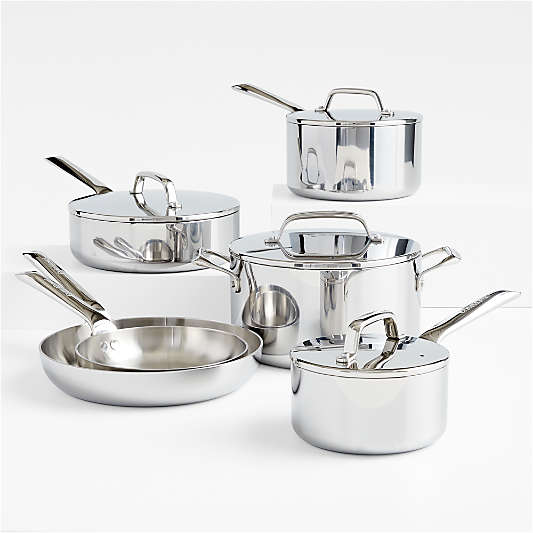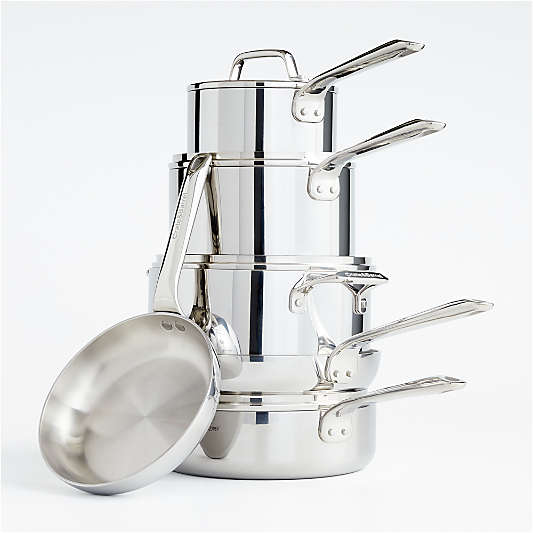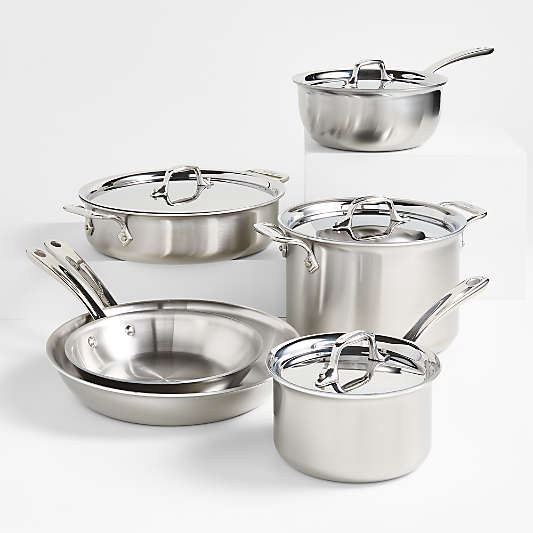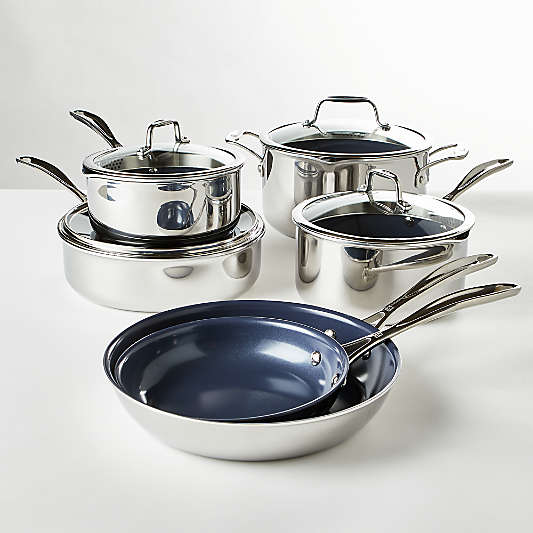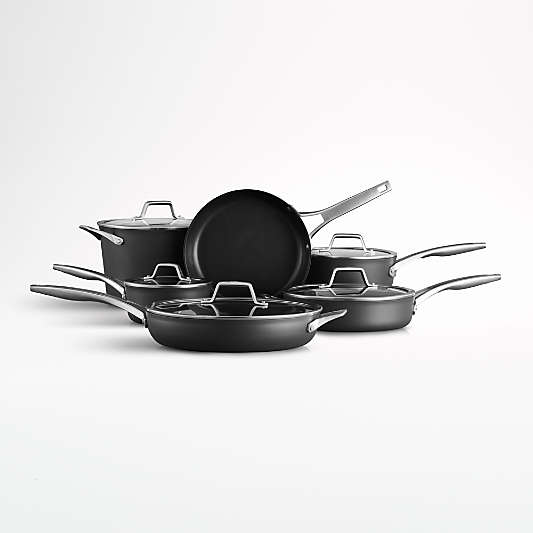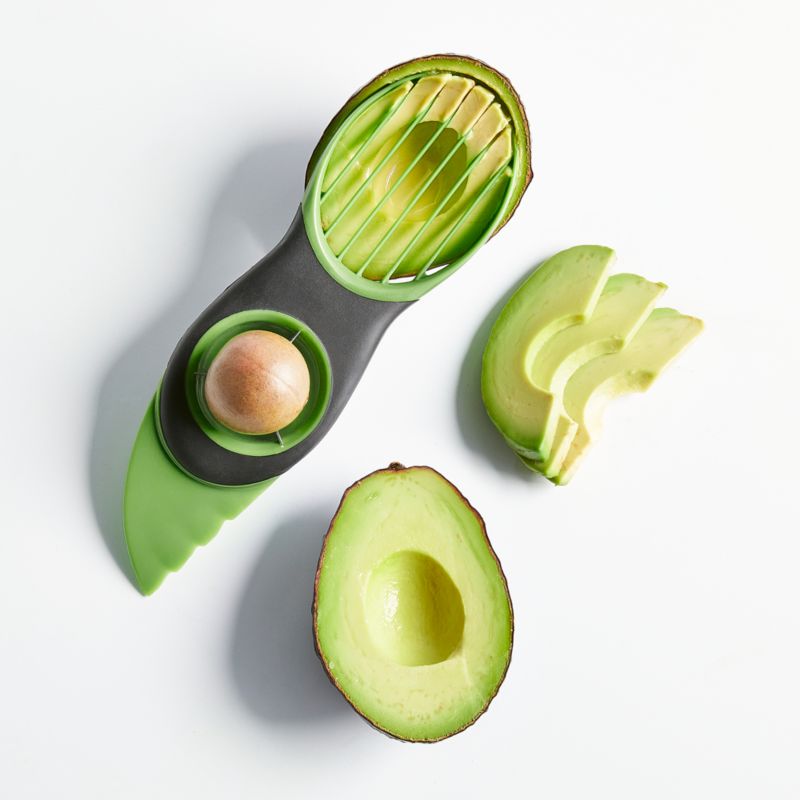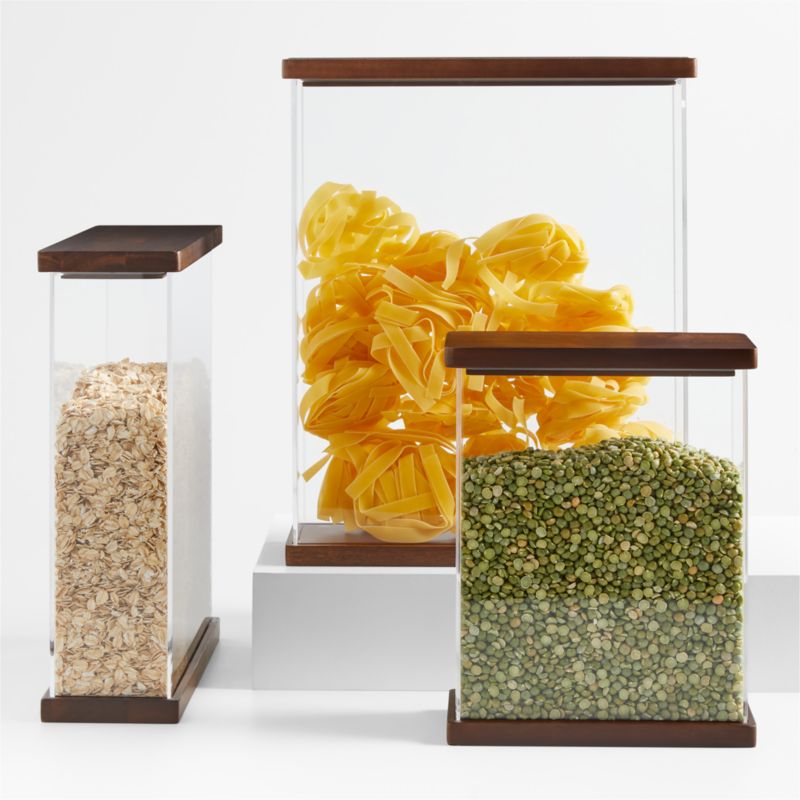the essential cookware buying guide
10 min read

Choosing cookware for your kitchen can be intimidating. Non-stick, cast iron, saute pan, frying pan…where to begin? This master guide on how to choose cookware will give you all the information you need to be able to buy the essential kitchen cookware that’s right for you.
Pots and pans are some of the most used and most versatile pieces of equipment in a home kitchen. With the proper research, you can find a handful of quality pieces that will help you achieve your culinary dreams whether that’s preparing a holiday meal for a crowd, cooking a one-pan dinner for two, or simply creating an affordable and minimal kitchen setup that’s ready for anything.
When choosing cookware, there are a few categories of information that you want to consider. In this guide, we’ll break them all down and take you through the type of cookware, the material, various reputable cookware brands and, of course, the care and cleaning instructions to make sure it's compatible with your needs and lifestyle.

types of kitchen cookware and their uses
DUTCH OVENS
Dutch ovens are one of the most versatile, timeless and durable types of cookware that you can have in your kitchen because they can go directly from the stovetop to the oven – and then to the table. A Dutch oven is a lidded pot with handles that’s the perfect vessel for soups, stews, beans, braised dishes, one-pot dinners, and even dishes like roast chicken or baked bread. A tight-fitting lid traps moisture, allowing for slow cooking since it limits evaporation. Traditionally made from heavy durable materials like enamel cast iron, Dutch ovens are now available in non-stick materials too if you are looking for a lighter or more affordable option.
FRYING PANS
Frying pans typically have a wide base and short sides. From making omelets to sautéing veggies, this essential piece of cookware has slanted sides that let you move ingredients around quickly, perfect for quick cooking. Frying pans are available in a variety of sizes, often from 8-inch to 12-inch, and it’s helpful to have a few options in your kitchen depending on the size of the recipe you are cooking and how many people you are looking to feed. Frying pan is another name for a skillet.
GRIDDLES
Not just for pancakes! Griddles are flat pans that transform your cooktop burner into a large flat cooking surface. They are so useful for breakfast foods like french toast, pancakes, eggs and bacon, but they are also the perfect pan for searing steaks, making fajitas, or even recrisping up a slice of last night’s pizza. You’ll typically find them made out of cast iron or nonstick materials. Note: Griddles can be sized to cover 1 or 2 burners on your stovetop.
GRILL PANS
No outdoor grill? No problem. A grill pan can help you make all your favorite grilled recipes indoors. Made with grill-like ridges that leave those desirable char marks, these pans allow you to make kebobs, grilled chicken, veggies, brats and more right on your stovetop. Grill pans are usually available in cast iron or non-stick finishes.
LASAGNA PANS
A lasagna pan is a type of rectangular bakeware that can vary in size from the typical 9"x13” pan to a larger size. It’s perfect for baking up a large lasagna to feed a crowd, but can also be used for all kinds of other baked recipes, like mac and cheese, a shepherd’s pie or even a blackberry cobbler. These pans typically feature rounded edges to make scooping out food easier, and can also be called bakers or baking dishes. Depending on the material, these pans can also be microwave-, dishwasher- and even freezer-safe, giving you more options for cooking and storing your favorite dishes.
PASTA COOKERS
Pasta cookers are also called pasta pots or multipots. These cleverly designed large stock pots feature a large perforated insert nested inside so you can easily and quickly strain cooked pasta. Use the pasta pot for other kitchen tasks like boiling potatoes and blanching vegetables to eliminate the need for an extra colander or a precarious trip to the sink with a pot of boiling water. If you are looking for even more versatility, look for a pasta pot with an additional perforated basket that can be used for steaming vegetables, fish or dumplings.
ROASTERS
A roaster or roasting pan is a hosting essential because it’s an ideal vessel for cooking large cuts of meat like a Thanksgiving turkey, a leg of lamb or even a dish as simple as a weeknight roast chicken. These pans come in a variety of sizes and you’ll find them in rectangular and oval shapes. A roasting pan often includes a rack that holds the meat above the pan, creating better air circulation around the food in the oven and allowing the drippings to flavor ingredients like potatoes and onions below.
SAUCE PANS
We consider a sauce pan one of the most basic kitchen essentials with its long handle, high straight sides and lid. Don't let the name deceive you—this do-it-all workhorse goes beyond sauce. Make gravy and syrups, reheat soup, prepare rice and potatoes, and boil or steam vegetables. Sauce pans are typically sized by volume and come in a variety of sizes, often from a small 1 quart up to a large 4 quart.
SAUCIERS
Similar to sauce pans, saucier pans are small to mid-size lidded pots with a single long handle. However, they have some key differences. Sauciers have curved rounded edges and shorter sides. A saucier will be a better pan for dishes that require more stirring like risotto or a custard because the round edges allow spatulas and whisks to continuously stir and prevent ingredients from getting stuck in the edges. The sloping sides allow for more evaporation as well so are also a great choice for sauces that require reduction like a balsamic glaze.
SAUTE PANS
The key difference between a saute pan and a frying pan is that a saute pan has straight sides and a frying pan has sloped sides. However, they can often be used interchangeably for things like sauteing vegetables or searing steaks. The straight sides of the saute pan are superior for recipes that require a little more liquid like a shallow fry or braising meat since the higher sides will trap the liquid and slow evaporation. Saute pans can also go from stovetop to oven making something like pan-roasted chicken thighs an easy dinner at home.
SKILLETS
What’s the difference between a skillet and a frying pan? There’s no difference. Skillet and frying pan are two different words to describe the same pan. A skillet has a wide base and sloped sides and is a great tool for sauteing vegetables or cooking a hash. You can find skillets made out of almost any cookware material including cast iron, non-stick, ceramic and stainless steel.
STEAMERS
Steaming is a fast, inexpensive and healthy way to cook your food and there are a variety of steamers available to help you in the kitchen. A pasta pot or multipot can function as a steamer, especially if they have a smaller perforated insert that holds the ingredients above the boiling water. You can also find separate steamer accessories like metal basketss or bamboo steamers that can work with your existing cookware. Typically you set the basket over an inch or so of boiling water, making sure to have a lid on top to trap the steam.
STOCK & SOUP POTS
A stock pot or soup pot is another essential piece of cookware. These pots are large enough to boil lots of water or simmer a big batch of soup for meal prep. Since stock pots and soup pots are typically made from stainless steel or nonstick materials, they are often lighter than dutch ovens of a similar size. This makes them a great choice if you are looking for a large volume pot but don't want it to be too heavy.

cookware brands
Cookware brands and craftsmanship make a big difference when choosing essential cookware. As experts in the cookware industry with decades of experience and customer feedback, we curate a highly selective collection to bring you the best of what’s out there.
Brad Kleparek, lead kitchen buyer for Crate & Barrel, says “What we don’t carry at Crate & Barrel is as important as what we do. We prioritize brands that we have tested for quality, longevity and craftsmanship and that we know will meet the high expectations of our customers, whether they are new to cooking or seasoned chefs. We offer a diverse selection of materials and beautiful design options to match any kitchen.” Here’s some helpful info on some of the best cookware brands out there:
ALL-CLAD
All-Clad is an American-made brand founded in 1971. Rooted in research, All-Clad cookware was among the first to sandwich a layer of heat-conductive metal between two layers of a non-reactive metal to create cookware that performed beautifully without compromising flavor. All-Clad cookware comes in classic stainless steel, deluxe copper and low-maintenance non-stick, handcrafted by skilled craftspeople in Canonsburg, PA.
CALPHALON
As one of the leading names in the American cookware industry, Calphalon made its name in the early 1960s with their revolutionary hard-anodized aluminum, which allowed them to manufacture cookware with the heat-conducting properties of aluminum and the characteristics of a non-reactive metal.
CRATE & BARREL
The Kitchen by Crate is Crate & Barrel’s in-house designed, private label collection of cookware. It brings home cooks design-forward, high-quality products and is built for both amateurs and novice cooks, at an attainable price. Available in stainless steel and ceramic pots, pans and sets, the innovative technology of heat-responsive copper EvenCook Core™ cookware is ideal for browning, searing, sauteing, boiling and simmering food.
CARAWAY
Caraway's mission is to raise cooks’ standards for cookware, from gorgeous design and color options to ease of use. Caraway pots and pans are made without PFOA, PTFE and PFAS.
CUISINART
A trusted name in kitchen essentials since 1973, Cuisinart products are built to last a lifetime and make all your favorite recipes a little easier. Cuisinart cookware is available in stainless steel, hard anodized non-stick, and their custom Ceramica® non-stick finish.
GREENPAN
Since 2007, professional and home chefs alike have relied on GreenPan products made without lead, cadmium, PFAS and PFOA. GreenPan cookware includes pots, pans and sets. GreenPan products are also scratch-resistant and dishwasher-safe, making your meal prep even easier.
LE CREUSET
The first in colorful cookware and a favorite for generations, Le Creuset tools reflect a dedication to design, style and quality. A trusted name in premium cookware for nearly 100 years, Le Creuset was founded in France in 1925 and has been producing their durable, iconically colorful cookware ever since. Today, the brand offers a full range of kitchen cookware necessities, including pots and pans, skillets, grill pans and Dutch ovens. An array of finishes, such as cast iron, ceramic, hard-anodized non- stick and aluminum-core stainless steel ensure that no matter what dish you're cooking, you'll have the right tools for the job.
LODGE
With its exceptional heat retention properties and a solid cast iron build, Lodge cookware has been a favorite of home chefs for over 125 years. Founded in 1896, Lodge cast iron cookware draws from its long history to bring their customers products that work not just now, but for a lifetime. The cookware is seasoned with a coating of food-safe oil so that it's ready to use as soon as you bring it home from the store.
STAUB
All Staub cookware is made of cast iron, a leading material for heat retention and distribution. This combined with the genius spikes beneath the lid, featured on most of their pots, grills and kettles, allows food to self-baste while cooking. The lid collects the condensation, and the spikes redistribute the moisture evenly onto the food. Staub cookware is beloved for its Made-in-France craftsmanship and beautiful glazed colors.

cookware materials
Deciding on the right material is one of the most important decisions when choosing cookware. The material–such as aluminum, cast iron, ceramic, or stainless steel–will determine what types of foods can be cooked in it, how heavy or light it is, and how you need to wash and care for it. You may find that you have a preferred cookware material for your whole kitchen or that you need different types of cookware materials for different applications.
ALUMINUM COOKWARE
Plain aluminum cookware is inexpensive, lightweight and heats up quickly, which is why you will find it at many discount and restaurant supply stores. However, plain aluminum is soft, does not retain heat very well and is also reactive with acidic foods which means you wouldn’t want to use acidic ingredients like tomatoes or lemon juice that could harm the pan or leach aluminum into your food. Aluminum pans are typically not induction compatible. However, because aluminum is an efficient conductor of heat, you also will find it used in conjunction with other materials like in hard-anodized aluminum cookware or aluminum core cookware.
CARBON STEEL COOKWARE
Cast iron lovers will love carbon steel cookware too. Like cast iron, carbon steel is known for its durability, but it is more lightweight and responds quicker to changes in temperature. Made primarily from carbon and iron, carbon steel cookware is induction compatible but is reactive to highly acidic foods. You’ll most often find it used for frying pans and woks where the thin, lightweight material is a benefit for high-heat cooking where you move the pan around. Carbon steel pans do require seasoning as part of their care, although some brands will come pre-seasoned to save you some of that work.
CAST IRON COOKWARE
Cast iron has been relied upon by generations of cooks for its affordability, longevity and ability to handle the high temperatures needed for searing and frying, as well as for baking bread, slow-simmering stews and slow-roasting dishes. When properly seasoned, it takes on a non-chemical, stick-resistant coating. Cast iron cookware is heavy and heats slowly and evenly and can also be used on an outdoor grill. Cast iron may be used on all stovetops, including induction. Cast iron is also called bare cast iron or non-enameled cast iron.
CERAMIC COOKWARE
Ceramic-coated cookware is a non-stick cookware option that is made without PTFE and PFOA. A ceramic coating is applied to another material like hard-anodized aluminum. They require little to no oils or fat during cooking and so can be a great option for low-oil cooking methods or foods that are prone to sticking like eggs, fish and other delicate ingredients. Ceramic cookware is typically oven-safe on low to medium heat and often comes in a variety of color options.
COPPER COOKWARE
Copper cookware has superior heat conductivity and a quick response to temperature changes. Extremely energy efficient, copper usually requires only a low or medium heat setting and cooks very evenly. For most modern copper cookware, copper is the material used in the core of the cookware or on the exterior to take advantage of the benefits of the material with a nonreactive stainless steel cooking surface that allows for the cooking of all ingredients, including acidic ones. Some copper pans have a magnetized base which makes them compatible with induction cooktops.
ENAMELED CAST IRON COOKWARE
Enameled cast iron cookware is cast iron that has been clad in smooth, vitrified porcelain, which helps prevent rust, makes for easier cleaning and requires no seasoning. Enameled cast iron comes in a variety of vibrant colors, and is best used at low to medium heats. At very high temperatures, enamel cast iron is prone to scorch marks from the oven. It does not hold odors or flavors and is non-reactive, which makes it ideal for cooking acidic foods such as tomato and wine sauces.
HARD-ANODIZED COOKWARE
If you are looking for a high heat cookware option, try hard-anodized cookware. Most hard-anodized cookware is coated with a non-stick finish so all kinds of foods can be cooked in it. In the anodizing process, the surface of aluminum is altered to create a stronger, more durable and non-reactive material compared to plain aluminum. You’ll find pans, pots, griddles, roasters and grill pans made out of this material.
NON-ENAMELED CAST IRON COOKWARE
Non-enameled cast iron (also called cast iron or bare cast iron) has been relied upon by generations of cooks for its affordability, longevity and ability to handle the high temperatures needed for searing and frying, as well as for slow-simmering stews and slow-roasting dishes. When properly seasoned, it takes on a non-chemical, stick-resistant coating. Cast iron cookware is heavy and heats slowly and evenly and can also be used on an outdoor grill. Cast iron may be used on all stovetops, including induction.
NON-STICK COOKWARE
Why is it so popular? Non-stick cookware offers non-fat cooking and great food release and, therefore, quick cleanup. It’s a great option for foods that are prone to sticking like eggs, pancakes, fish, crepes and more. At Crate & Barrel, we bring today's cook the most cutting-edge nonstick technologies without sacrificing an ounce of style. Our non-stick collections include hard-anodized and ceramic-coated.
STAINLESS STEEL COOKWARE
Stainless steel cookware is non-reactive with high-acidic foods. Typically, its multi-ply construction has a thick aluminum or copper core to cook with even heat distribution. The polished stainless steel interior will not discolor from foods, and the gleaming stainless exterior is usually magnetic, making it suitable for induction as well as traditional cooktops.

parts of cookware
These basic terms will help you get to know the various parts of cookware and what to look for in each category.
COATING
Coating refers to a material–like a non-stick finish–that’s placed on top of another material, usually a metal. This allows the cookware item to reap the benefits of two or more materials. For example, in hard-anodized cookware, you get the strong heat conductivity and affordability of aluminum and the ease of cooking and cleaning and non-reactivity with acidic foods of a non-stick finish.
CLADDING
Cladding refers to layering sheets of metal and bonding them together, like you find in multi-ply stainless steel cookware. The multiple layers allow you to combine benefits from the different metals. Aluminum and copper are typically the inner metal which is very responsive to changes in heat, and stainless steel is typically the outer metal that’s non-reactive with acidic foods and easy to clean. Pans can be clad, which means that the bottom has these sandwiched layers of metal, or fully clad, which means layers are on both the base and the sides of the pan.
HANDLE
Handles allow you to move the cookware around. They can be made of different materials like wood, silicone, or metal. Metal and silicone handles are oven safe at most temperatures, whereas plastic and wood handles are usually not. Silicone, wood, and plastic handles will not heat up as much on the stovetop.
RIVETS
Rivets hold two pieces of metal together like the handle of a pan to the body. Sometimes welding is used instead to fasten different parts of the pan together.
BODY
The body is the large part of the pot or pan that you cook in. The body of a pan is usually measured by the diameter of the base (ex: 8-inches) whereas the body of a pot is usually measured by volume (ex: 2 quarts).
RIM
The rim is the edge of the pot or the pan. The rim can be straight which is good for containing ingredients or it can be slightly curved or contain a spout which makes pouring liquids easier.
SURFACE
The surface is the inside part of the cookware that’s in contact with your food. Choose a surface material that’s compatible with what you plan to cook. Try stainless steel for acidic foods like tomatoes, non-stick for stick-prone foods like eggs or cast-iron for a perfectly seared finish on a steak.
CORE
Core is the inner metal that’s sandwiched between the outer layers of the metal. The core material is often aluminum or copper which are both excellent conductors of heat.
SIDES
The sides of a pot or pan can be either high or low and either straight or sloped. Typically, high, straight sides prevent evaporation and are good for long cooking or simmering recipes like soups and stews. Low, sloped sides encourage evaporation and are good for recipes that need lots of stirring, like sauce reductions or risotto.
BASE
The base is the bottom part of the cookware that comes in contact with your cooking surface like an electric, gas or induction stove. Pay attention to the base if you are looking for induction-compatible cookware. The base must contain a ferromagnetic metal (like cast iron or magnetic stainless steel).
LID
Not all cookware comes with a lid and some lids can be interchangeable among cookware pieces. Lids can trap moisture and heat and are necessary for cooking some ingredients like rice. Glass lids allow you see what’s cooking inside without opening the lid. Pay attention to the material for the handle on the lid if you like to put your cookware in the oven because some materials like plastic and wood are not oven-safe at high temperatures.

cookware care
With proper care, cleaning and storage, you can maximize the lifespan of your cookware. Many pieces will even last a lifetime. Some materials require more or less care, so be sure to choose cookware that works for your lifestyle. Note that these are general cleaning guidelines based on the cookware material, but you should always consult the manufacturer guides for care instructions for your specific pots and pans. In general, non-food safe and harsh chemicals should be avoided.
HOW TO CLEAN ALUMINUM COOKWARE
Aluminum pans should not be put in the dishwasher. Wash by hand with soap, water and a non-abrasive sponge. Be careful when heating to avoid warping and tarnishing. When aluminum pans discolor over time or get pitted, it’s time to replace them.
HOW TO CLEAN CARBON STEEL COOKWARE
Unlike stainless steel, carbon steel does not contain chromium which protects against rust, so when it is exposed to moisture for a long period of time, it can rust. Carbon steel should be regularly seasoned with oil to prevent rusting and to maintain the stick-resistant finish. It should be washed and dried by hand and not put in the dishwasher.
HOW TO CLEAN CAST IRON COOKWARE
Allow cast iron to cool before contact with water, then clean promptly with plain water or mild soapy water. If left wet, cast iron is prone to rusting. Dry immediately and rub with a light coat of vegetable oil. Re-season periodically. Do not soak. Since cast iron cookware can be heavy, try storing it in lower cabinets. With proper care and regular seasoning, cast iron cookware can last a lifetime.
HOW TO CLEAN CERAMIC COOKWARE
Though ceramic non-stick cookware is often dishwasher-safe, hand washing is recommended. Allow pans to cool thoroughly before placing in cold water. Use silicone or wood utensils only.
HOW TO CLEAN COPPER COOKWARE
Copper cookware should be washed by hand. Use a mild detergent and a soft sponge. Avoid bleach and abrasive cleaners. To remove tarnish and dark spots, try copper polish made for cookware and a soft cloth.
HOW TO CLEAN ENAMELED CAST IRON COOKWARE
Cook with non-metal tools to avoid chipping the enamel. Allow to cool before contact with water, then clean promptly with mild soapy water. If there is food residue, fill with warm water and soak for 15 to 20 minutes before washing. Dry thoroughly. Enameled cast iron is dishwasher safe, but hand-washing is recommended to retain the enamel’s shine. Since enamel cast iron cookware can be heavy, try storing it in lower cabinets. High oven temperatures may leave scorch marks on the enamel which are hard to remove, so consult the specific manufacturer instructions to verify.
HOW TO CLEAN HARD-ANODIZED COOKWARE
Let pans cool thoroughly before washing, and avoid placing hot pans in cold water. Most non-stick cookware can go in the dishwasher, but repeated dishwasher use can lead to drying of the non-stick surface. Hand-washing will prolong the life of the pan. Use detergents that don’t contain bleach or citrus additives. Non-stick cookware is safe for use on most stovetops. Use nylon-coated or wood utensils only. Be careful storing non-stick pans stacked with other cookware to prevent scratching on the cooking surface. Try layering fabric protectors between the pieces or using a vertical or horizontal pot organizer. If you notice chips in the finish or that the surface feels stickier, even when clean, it’s time to replace.
HOW TO CLEAN NON-ENAMELED CAST IRON COOKWARE
Allow cast iron to cool before contact with water, then clean promptly with plain water or mild soapy water. If left wet, cast iron is prone to rusting. Dry immediately and rub with a light coat of vegetable oil. Re-season yearly. Do not soak. Since cast iron cookware can be heavy, try storing it in lower cabinets. With proper care and regular seasoning, cast iron cookware can last a lifetime.
HOW TO CLEAN NON-STICK COOKWARE
Let pans cool thoroughly before washing, and avoid placing hot pans in cold water. Most non-stick cookware can go in the dishwasher, but repeated dishwasher use can lead to drying of the non-stick surface. Hand-washing will prolong the life of the pan. Use detergents that don’t contain bleach or citrus additives. Non-stick cookware is safe for use on most stovetops. Use nylon-coated or wood utensils only. Be careful storing non-stick pans stacked with other cookware to prevent scratching on the cooking surface. Try layering fabric protectors between the pieces or using a vertical or horizontal pot organizer. If you notice chips in the finish or that the surface feels stickier, even when clean, it’s time to replace.
HOW TO CLEAN STAINLESS STEEL COOKWARE
Stainless steel cookware is dishwasher-safe and durable and is compatible with induction as well as traditional cooktops. Avoid bleach and abrasive cleaners. According to Alia Dalal, a trained chef and Crate & Barrel’s in-house culinary expert, “If you have any burned-on stains, you can try simmering water in the pan to break them up or using a plastic or silicone scraper to remove food particles. A paste made from baking soda and water can also help act as a mild abrasive to remove food.” For a spotless shine after washing, hand dry each piece. Stainless steel cookware is suitable for use with all utensils, even metal.

how many pots and pans do i need?
There is no set number of pots and pans that everyone needs in your kitchen. It’s totally dependent on what you like to cook, how many people you are typically cooking for and your home kitchen setup including the type of stove and how much storage you have. However, we have some suggestions to get you started on building your essential cookware collection.
INDIVIDUAL COOKWARE
According to Alia Dalal, a trained chef and Crate & Barrel’s in-house culinary expert, there are a few staple cookware items you want to stock in a basic home kitchen. “You don’t need to have cabinets full of cookware, especially in a smaller kitchen, but if you have a 12-inch stainless steel frying pan, a stock pot and a mid-size sauce pan, you can cook almost anything. After that, the next pieces I would add are a high-quality non-stick skillet for convenience and a large enamel cast iron dutch oven.” Dalal also recommends buying bigger sizes if you have limited space. “You can usually cook a smaller amount of food in a large pan, but not the other way around.”
COOKWARE SETS
If you have a new home or need to outfit a whole kitchen, a cookware set is a great option because it will provide you a curated set of popular pots and pans, typically at a discounted rate compared to purchasing them all separately. Many different brands like All-Clad, Caraway and Calphalon sell cookware sets and you can choose from stainless steel, ceramic, or non-stick sets. One unique feature of cookware sets is that the lids are sometimes interchangeable between more than one piece of cookware, giving you even more value and space efficiency. Certain brands like Staub also sell stacking cookware sets to help keep your cabinets organized and maximize space. Cookware sets also make a great gifting option for wedding registries, graduations, and housewarmings because they can set someone up with everything they need to get started or upgrade their kitchen.

cookware organization and storage
One challenge that comes up when you get new cookware is how to store and organize all of it. Crate & Barrel has a wide variety of kitchen storage options and organizers to keep your cookware organized and in good shape.
ORGANIZERS FOR POTS AND PANS
Pots and pans can easily get disorganized in cabinets, and it can become hard to easily find the piece of cookware you are looking for. One option is an organizer, like a multi-tier standing pot rack that has small shelves for different pieces of cookware. A standing rack can fit neatly in a corner and is a great solution if you don’t have lots of space in your cabinets or drawers.
HANGING POT RACKS
A hanging pot rack is a great option if you have limited cabinet or drawer space. Sturdy hooks are suspended from the wall, a shelf or directly from the ceiling, allowing you to take advantage of unused vertical space. This is a visually impressive way to display premium cookware and give your space a chef’s kitchen flair.
POT LID ORGANIZERS
Pot lids don’t need to be the bane of your existence. Many cookware sets include a pan or pot lid organizer that props up each lid vertically like they are lined up on a bookshelf. You can also purchase pot lid organizers separately to organize lids from different brands. Pot lid organizers are a space-efficient way to store a lot of lids vertically and let you instantly access the lid that you need.
DRAWER POT AND PAN ORGANIZERS
Many kitchen designs now feature deep drawers that are perfect for storing cookware. You can insert a pot lid or pan organizer directly into a deep drawer and get the benefits of this type of storage in your existing cabinetry.

